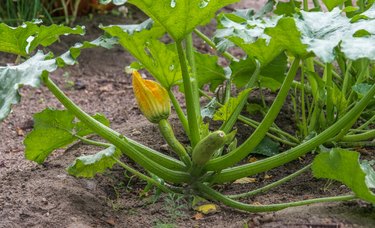
In a group of plants collectively called cucurbits, types of annual squash (Cucurbita spp.) have different growth habits and bear different types of fruit. Although squash commonly is referred to as a vegetable, it actually produces fruit because of the botanical characteristics of this edible part. Regardless of the type of plant you're growing, the common parts of squash plants are similar, with only a few notable differences.
The two primary types of squash names are summer squash and winter squash. Although all types are grown as annuals during warm weather, "winter" squash may be a confusing term for some gardeners. You don't actually grow winter squash during the same-named season; this term hints at its longer storage potential than summer squash.
Video of the Day
Video of the Day
Squash Stems and Leaves
Squash leaves are large to help shade the developing fruit from the sun. If fruit receives too much direct sun, it is susceptible to a physiological disorder known as sunscald. If you see areas of discoloration, which typically are white, on exposed squash fruit, it's likely caused by too much direct sun. When the protective broad leaves cannot shield the developing fruit, whether because they've been broken or damaged by disease, the fruit may suffer sunscald as a result.
Squash stems may form a bush-type growth habit, or they may develop into long, sprawling structures that form a vining habit. Formerly, summer squash was regarded as bush types and winter squash was regarded as vining types. But with the introduction of newer cultivars has come a bit of a crossover with these terms, and some types of winter squash are bush types instead of vining plants. For example, the stems of Butterbush butternut winter squash (Cucurbita moschata 'Butterbush') grow into a bush-type form, while the stems of the traditional Waltham butternut winter squash (Cucurbita moschata ' Waltham') take a vining form.
Flowers Fulfill the Squash Specialized Function
Although separate male and female flowers appear on each squash plant, the timing of their opening varies. Early in the season, you may see lots of flowers on your squash plants without any developing into fruit. The reason is that these first blooms are all male flowers; the female flowers will follow. These early male flowers attract pollinators, and by the time the female flowers appear, the squash plant has successfully "trained" these pollinators into visiting the plants.
This squash specialized function of adaptation helps increase the chances of successful pollination. Without successful pollination, and subsequent fertilization of the flowers, the squash plant cannot set fruit. You'll be able to tell the difference between male and female squash flowers by looking at the flower stalk beneath each bloom. If it's a male flower, the stalk will be straight and slender; if it's a female flower, you'll see a slight swelling at the base of the bloom. If pollinators are successful in fertilizing the female flowers, this slight swelling develops into fruit.
Squash Roots and Potential Problems
A healthy squash root system is essential for maintaining healthy growth of a plant. Because roots uptake water and nutrients from the soil, too much – or too little – water throws the water/nutrient balance off-kilter. This not only compromises the health of the squash plant but also creates an environment that promotes disease and fosters disorders. The symptoms of these problems may appear in the leaves, stems or fruits.
For example, when squash plants receive too much water, whether it's because of excessive rainfall/irrigation or soil that doesn't drain well and retains too much water, they become vulnerable to root rot. Caused by fungal pathogens that breed in moist conditions, including Pythium spp. and Phytophthora spp., root rot can manifest by stems that wilt and plant crowns that collapse. Drought stress also causes the same symptoms of wilting and plant collapse; however, you can easily tell the difference by whether plants have received an abundance of water … or not enough.
The Missouri Botanical Garden describes a problem that may give squash plants the appearance of disease. Oedema is a physiological order that's not caused by disease. When squash roots uptake water faster than the plant can use or express through transpiration, turgor pressure builds up in the plant cells. This pressure can cause cells to burst, leaving a blister-like appearance on fruits and leaves.
The University of Georgia Extension recommends giving squash plants between 1 to 1 1/2 inches of water each week, in the absence of sufficient rainfall. Make sure the water penetrates 6 to 8 inches into the soil. Growing squash plants on raised beds improves drainage in areas with heavy rainfall or on sites with heavy clay soil that doesn't drain well.